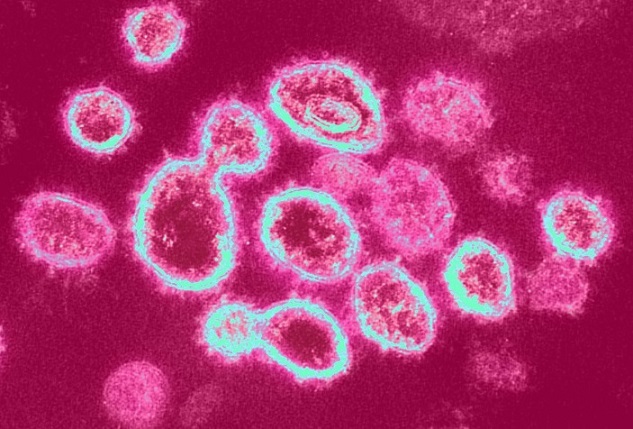New Study Unveils How Influenza Virus Exploits CXCL8-MAPK-hnRNP-K Pathway to Enhance Infection
Nikhil Prasad Fact checked by:Thailand Medical News Team Feb 18, 2025 1 month, 3 weeks, 2 days, 16 hours, 56 minutes ago
Medical News: Understanding the Role of CXCL8 in Influenza Virus Infection
A groundbreaking study conducted by researchers from multiple institutions, including the Chinese Academy of Sciences and Shanghai Jiao Tong University, has uncovered a crucial mechanism by which the influenza virus manipulates the body's immune signaling pathways to enhance its replication and spread. This
Medical News report highlights how the virus exploits the CXCL8/MAPK/hnRNP-K signaling axis, shedding new light on viral replication strategies and potential therapeutic targets.
 New Study Unveils How Influenza Virus Exploits CXCL8-MAPK-hnRNP-K Pathway to Enhance Infection
The CXCL8 Signaling Axis and Influenza Virus
New Study Unveils How Influenza Virus Exploits CXCL8-MAPK-hnRNP-K Pathway to Enhance Infection
The CXCL8 Signaling Axis and Influenza Virus
CXCL8, also known as interleukin-8, is a cytokine that plays a vital role in immune system responses by recruiting white blood cells to sites of infection. However, the influenza virus has been found to exploit this system for its own benefit. The study revealed that upon infection, the influenza virus triggers an increase in CXCL8 production, which subsequently activates the MAPK signaling pathway. This activation leads to the translocation of hnRNP-K, a key RNA-binding protein, from the nucleus to the cytoplasm.
hnRNP-K is essential for the recognition and processing of viral RNA, facilitating the replication of the virus within host cells. By hijacking this mechanism, the influenza virus ensures a more efficient production of its genetic material, allowing it to spread more effectively within the respiratory system. These findings suggest that blocking CXCL8 or its downstream signaling pathways could be a viable approach to reducing viral replication and controlling influenza infections.
Key Findings of the Study
The research team conducted extensive in vitro experiments to examine the role of the CXCL8/MAPK/hnRNP-K axis in influenza virus replication. Several significant discoveries emerged from their study:
-CXCL8 is upregulated upon influenza virus infection: The study demonstrated that influenza A virus (IAV) infection leads to a significant increase in CXCL8 expression, which in turn activates the MAPK signaling cascade.
-MAPK signaling facilitates viral replication: The activation of MAPK signaling promotes the cytoplasmic translocation of hnRNP-K, a process necessary for efficient viral RNA processing.
-hnRNP-K enhances viral RNA recognition and replication: Once in the cytoplasm, hnRNP-K interacts with the viral RNA, assisting in its replication and the production of new viral particles.
-Blocking CXCL8 disrupts viral replication: Silencing CXCL8 expression or inhibiting the MAPK pathway significantly reduced the efficiency of influenza virus replication in vitro, highlighting a potential target for antiviral interventions.
Implications for Influenza Treatment
The findings of this study op
en new avenues for influenza treatment by targeting the CXCL8 signaling pathway. Given that CXCL8 plays a crucial role in inflammation, excessive activation of this pathway not only aids viral replication but also contributes to severe immune responses, potentially leading to complications such as cytokine storms.
Developing drugs that specifically inhibit CXCL8, MAPK signaling, or hnRNP-K translocation could help in reducing both viral replication and excessive immune activation. The study also suggests that existing MAPK inhibitors, currently used in cancer treatments, could be repurposed for combating influenza infections. However, further research and clinical trials are necessary to validate these findings in real-world scenarios.
Future Research Directions
While this study provides critical insights into the molecular interactions between influenza virus and the host immune system, some limitations exist. The research was primarily conducted in vitro, meaning that further validation in animal models and human trials is required to determine the full therapeutic potential of targeting CXCL8 signaling in influenza infections.
Moreover, given the involvement of CXCL8 in multiple respiratory viruses, including rhinovirus and enterovirus D68, scientists are interested in exploring whether similar therapeutic strategies could be applied to other viral infections.
Understanding the broader implications of CXCL8 signaling could lead to the development of broad-spectrum antiviral therapies that target multiple respiratory pathogens simultaneously.
Conclusion
This study represents a significant step forward in understanding how influenza virus manipulates host immune responses to enhance its replication. By hijacking the CXCL8/MAPK/hnRNP-K axis, the virus creates an environment conducive to its own survival and proliferation. The identification of this mechanism not only expands our knowledge of influenza virus biology but also provides promising new targets for antiviral drug development.
As influenza continues to pose a global health threat, especially with the emergence of new viral strains, innovative therapeutic strategies are urgently needed. Targeting the CXCL8 pathway could offer a novel approach to controlling influenza infections and reducing the severity of outbreaks.
The study findings were published in the peer-reviewed journal: Nature Communications.
https://link.springer.com/article/10.1038/s41467-025-57094-0
For the latest Influenza News, keep on logging to Thailand
Medical News.
Read Also:
https://www.thailandmedical.news/news/an-update-on-approved-and-innovative-therapeutic-approaches-to-combatting-influenza-viruses
https://www.thailandmedical.news/news/u-s-nih-study-finds-that-influenza-a-virus-adapts-its-shape-to-survive-and-spread
https://www.thailandmedical.news/news/new-insights-into-influenza-a-virus-receptors-and-potential-treatments
https://www.thailandmedical.news/articles/influenza-or-flu
https://www.thailandmedical.news/articles/h5n1-avian-flu
https://www.thailandmedical.news/pages/thailand_doctors_listings
